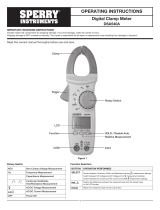
Page 3<&(%$*4.8"4,7%H'*#$"&8#I%/7*,#*%4,77%JKLLLKLMMKNOPO1Item 64020
?@<6ATVX6;@ACVED@CEA6E@EQ6 ?6AFX
CDXV;A@EA%?@<6AT%CE<V;D@ACVE
?,2*$>%R,(8"83#%,89%X(*4,'$"&8#
;*,9%,77%#,2*$>%),(8"83#%,89%,77%"8#$('4$"&8#1%%
Failure to follow the warnings and instructions may result
in electric shock, fire and/or serious injury.
?,Y*%,77%),(8"83#%,89%"8#$('4$"&8#%2&(%2'$'(*%(*2*(*84*1
1. Electrical shock can cause death
or injury! NEVER TOUCH exposed
conductors of electricity.
2. A*#$%4,+7*%Y&7$,3*#%)"$.%4,(*1
Only use one hand when securing
the clamp around cable.
3. Inspect the Meter before use. In
addition to a general inspection:
a. Check the insulation
protecting the connectors.
b. Check the Test Leads for
exposed metal, damaged
insulation, and continuity.
c. Replace damaged test lead
immediately, before use.
4. Do not use the Meter if:
a. Either of the Test Leads are
damaged in any way.
b. Test Leads are dirty or
have residue on them.
c. The battery is low.
d. Near any explosive
gasses or fumes.
e. Any abnormal operation is
detected. (If in doubt about
the condition of the Meter,
have it serviced before use.)
f. The battery cover is open.
5. Power this Meter using only
the battery(ies) referenced in
the Specifications Chart.
6. Use caution when working near
voltages above 30 VAC rms, 42 VAC
peak, or 60 VDC. Voltages this high
present a risk of electric shock.
7. Disconnect the circuit’s power
before connecting the meter in
series, when measuring current.
8. Connect the common (COM) test
lead first and disconnect it last.
9. Hold the probes with fingers
behind guards.
10. Avoid electrical shock. Use extreme
caution when working near uninsulated
conductors or bus bars. Prevent body
contact with grounded surfaces such
as pipes, radiators, ranges, and cabinet
enclosures when testing voltages.
11. Observe work area conditions. Do
not test voltages in damp or wet
locations. Don’t expose to rain.
Keep work area clean and well lit.
12. Keep children away. Children must
never be allowed in the work area.
13. Stay alert. Watch what you are doing,
use common sense. Do not operate
any meter when you are tired.
14. Do not operate meter if under the
influence of alcohol or drugs. Read
warning labels on prescriptions
to determine if your judgment or
reflexes are impaired while taking
drugs. If there is any doubt,
do not operate the meter.


















